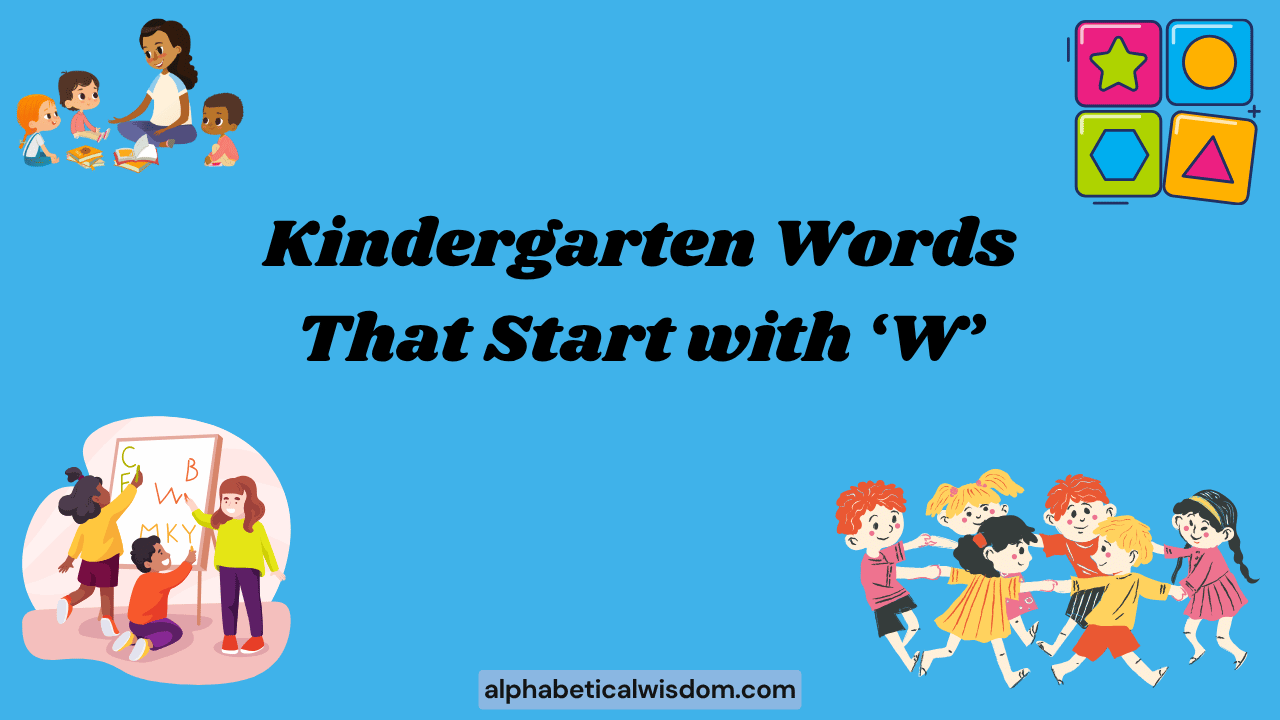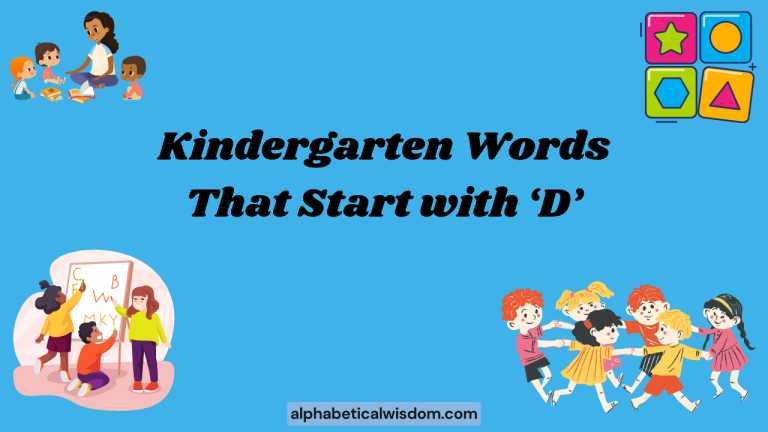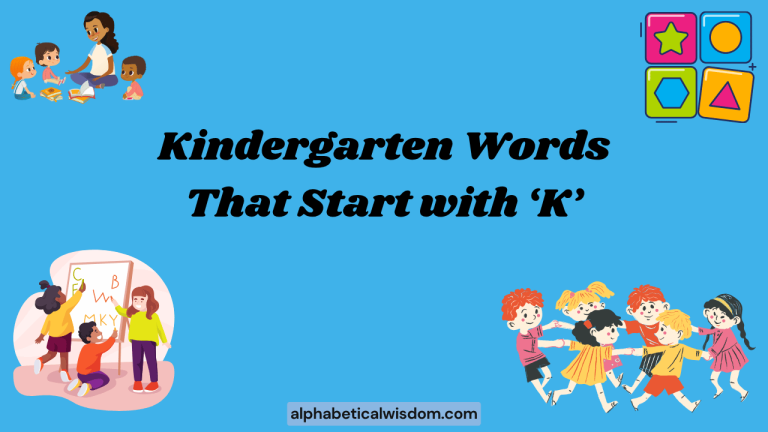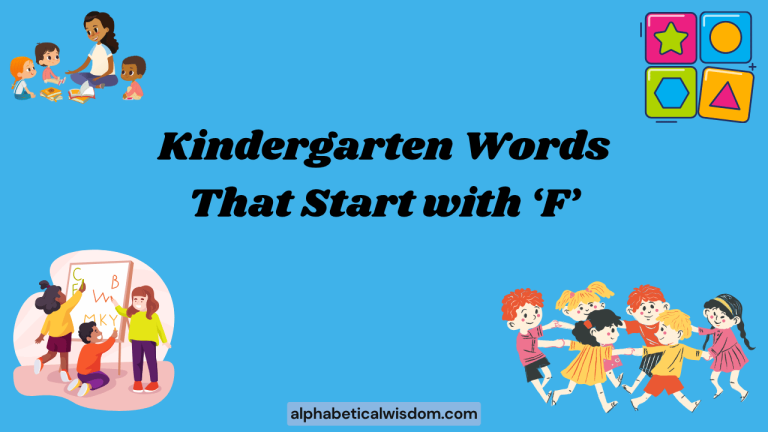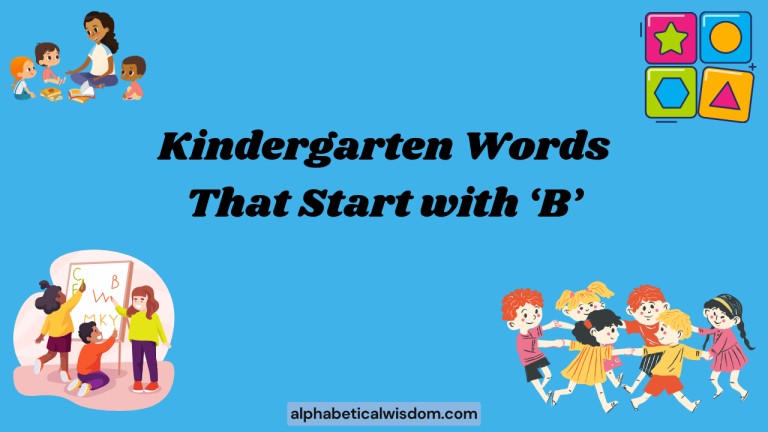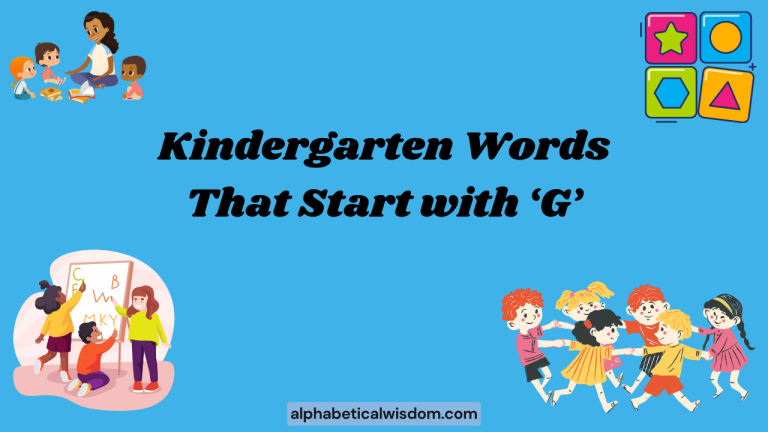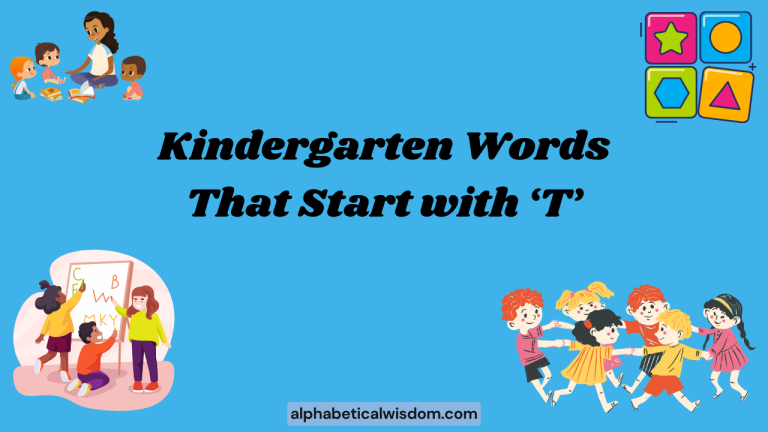Kindergarten Words That Start With W: A Comprehensive Guide
Learning the alphabet is a foundational step in a child’s education, and mastering words starting with each letter is crucial for building vocabulary and reading skills. This article focuses on kindergarten-level words that begin with the letter “W.” Understanding these words helps children develop phonemic awareness, expand their expressive language, and improve their overall literacy.
This guide is designed for parents, teachers, and educators who are looking for comprehensive resources to support young learners in their language development journey. By exploring definitions, examples, and practical exercises, children can confidently use these “W” words in their daily communication.
Table of Contents
- Introduction
- Definition of Kindergarten Words That Start With W
- Structural Breakdown of Words Starting with W
- Categories of “W” Words for Kindergarten
- Examples of “W” Words
- Usage Rules for Words Starting with W
- Common Mistakes with “W” Words
- Practice Exercises
- Advanced Topics
- FAQ
- Conclusion
Definition of Kindergarten Words That Start With W
Kindergarten words that start with the letter “W” are vocabulary terms appropriate for children aged 4-6 years old. These words are typically simple, phonetically regular, and commonly used in everyday language.
They often represent familiar objects, actions, or concepts that kindergarteners can easily understand and relate to. The function of these words is to build a foundational vocabulary that supports early reading, writing, and communication skills.
These words provide the building blocks for more complex language development as children progress through their education.
In the context of language development, “W” words serve as a gateway to understanding broader linguistic patterns. They help children recognize the sound-letter correspondence, which is crucial for decoding written words.
Furthermore, these words are used in various settings, including classrooms, homes, and play environments, making them highly relevant to a child’s daily life. Learning these words equips children with the necessary tools to express themselves effectively and comprehend simple instructions and stories.
Essentially, mastering “W” words is a key component in fostering early literacy and language proficiency.
Structural Breakdown of Words Starting with W
The letter “W” typically represents a consonant sound formed by rounding the lips and producing a voiced sound. Structurally, words starting with “W” often follow simple phonetic patterns that are easy for young learners to decode. Many of these words are short and consist of only a few phonemes, making them manageable for kindergarteners to pronounce and spell. Common patterns include “W” followed by a vowel (e.g., we, way) or “W” followed by a consonant (e.g., wrap).
Understanding the structural elements of “W” words also involves recognizing the placement of the letter within the word. In most cases, “W” appears at the beginning, setting the stage for the rest of the word’s pronunciation. Additionally, recognizing the vowel sounds that follow “W” is crucial for accurate pronunciation and spelling. For instance, the “a” in water has a different sound than the “e” in wet. Teaching children to identify these patterns helps them develop strong phonetic skills and enhances their ability to read and write independently.
Categories of “W” Words for Kindergarten
“W” words for kindergarten can be categorized into several groups based on their meaning and usage. These categories help children understand the different contexts in which these words can be used and expand their vocabulary in a structured way.
Common “W” Words
These are frequently used words that form the basis of everyday communication. Examples include we, was, want, and with. These words are essential for constructing simple sentences and understanding basic instructions.
Animal “W” Words
These words refer to animals whose names begin with “W,” such as whale, wolf, and wasp. Learning these words helps children expand their knowledge of the natural world and recognize different animal species.
Action “W” Words
These are verbs that start with “W,” describing actions or activities. Examples include walk, wash, wave, and write. Understanding these words enables children to describe what they and others are doing.
Descriptive “W” Words
These are adjectives that begin with “W,” used to describe qualities or characteristics. Examples include warm, wet, wide, and wonderful. These words help children add detail and precision to their descriptions.
Object “W” Words
These are nouns that start with “W,” referring to tangible items or objects. Examples include water, window, wagon, and watch. Learning these words helps children identify and name common objects in their environment.
Examples of “W” Words
Providing numerous examples is crucial for reinforcing the understanding of “W” words. The following tables present various “W” words categorized by their type, along with example sentences to illustrate their usage.
Common “W” Words
Common “W” words are the most frequently used in everyday language. These words are essential for building basic sentences and understanding simple instructions.
The table below provides a list of common “W” words along with example sentences.
| Word | Example Sentence |
|---|---|
| We | We are going to the park. |
| Was | The dog was sleeping. |
| Want | I want to eat an apple. |
| With | I like to play with my friends. |
| Will | She will read a book. |
| What | What is your name? |
| When | When is your birthday? |
| Where | Where do you live? |
| Why | Why are you sad? |
| Which | Which color do you like? |
| Who | Who is that person? |
| Were | They were playing outside. |
| Well | I am feeling well today. |
| Went | He went to school. |
| Walk | Let’s walk to the store. |
| Way | This is the way to the beach. |
| Week | There are seven days in a week. |
| While | I read a book while waiting. |
| White | The snow is white. |
| Word | That is a big word. |
| Work | I like to work on puzzles. |
| World | The world is a big place. |
| Write | I can write my name. |
| Would | I would like some juice. |
| Wasn’t | It wasn’t me. |
| We’re | We’re going home. |
| We’ll | We’ll see you soon. |
Animal “W” Words
Animal “W” words help children learn about different types of animals. These words can be used in simple sentences to describe the animals and their characteristics.
The following table provides a list of animal “W” words along with example sentences.
| Word | Example Sentence |
|---|---|
| Whale | The whale is a very big animal. |
| Wolf | The wolf howls at the moon. |
| Wasp | A wasp can sting you. |
| Worm | The worm lives in the dirt. |
| Wallaby | The wallaby hops around in Australia. |
| Wren | The wren is a small bird. |
Action “W” Words
Action “W” words are verbs that describe different actions. These words help children express what they and others are doing.
The following table provides a list of action “W” words along with example sentences.
| Word | Example Sentence |
|---|---|
| Walk | I like to walk in the park. |
| Wash | Please wash your hands. |
| Wave | I wave goodbye to my mom. |
| Write | I can write my name. |
| Wiggle | The worm wiggles in the ground. |
| Wink | He winked at me. |
| Whisper | Don’t whisper during the test. |
| Wipe | Can you wipe the table, please? |
Descriptive “W” Words
Descriptive “W” words are adjectives that describe qualities or characteristics. These words help children add detail and precision to their descriptions.
The following table provides a list of descriptive “W” words along with example sentences.
| Word | Example Sentence |
|---|---|
| Warm | The sun is warm today. |
| Wet | The ground is wet after the rain. |
| Wide | The river is very wide. |
| Wonderful | This is a wonderful day. |
| Whole | I ate the whole apple. |
| Weak | The branch is weak and might break. |
Object “W” Words
Object “W” words are nouns that refer to tangible items or objects. These words help children identify and name common objects in their environment.
The following table provides a list of object “W” words along with example sentences.
| Word | Example Sentence |
|---|---|
| Water | I drink water when I am thirsty. |
| Window | I can see outside through the window. |
| Wagon | I pull my toys in a wagon. |
| Watch | I wear a watch to tell time. |
| Wall | The picture hangs on the wall. |
| Wood | The table is made of wood. |
| Wings | Birds have wings to fly. |
| Wool | The sweater is made of wool. |
Usage Rules for Words Starting with W
Understanding the rules for using “W” words correctly is essential for developing strong language skills. While most “W” words follow simple phonetic rules, there are some exceptions and special cases to be aware of.
- Phonetic Pronunciation: The letter “W” typically makes a “woo” sound, as in water or walk.
- Silent “W”: In some words, the “W” is silent, especially when followed by the letter “r,” such as in write or wrong.
- “Wh” Digraph: The combination of “wh” can produce a “w” sound or an “hwoo” sound, depending on the word. For example, what is pronounced with a “w” sound, while who is pronounced with an “hwoo” sound.
- Contextual Usage: The meaning of “W” words can vary depending on the context. For example, walk can be a verb (to move on foot) or a noun (a leisurely stroll).
It is important to teach children these rules and exceptions through explicit instruction and practice. Providing examples and engaging in interactive activities can help them internalize these concepts and use “W” words correctly in their speech and writing.
Common Mistakes with “W” Words
Even with proper instruction, children often make common mistakes when learning “W” words. Addressing these mistakes directly can help reinforce correct usage and prevent the development of incorrect habits.
| Incorrect | Correct | Explanation |
|---|---|---|
| Watter | Water | Misspelling due to phonetic similarity. |
| Rite | Write | Confusing with homophones (words that sound alike but have different meanings). |
| Wich | Which | Misspelling due to phonetic similarity. |
| Ware | Were | Confusing with homophones. |
| Whent | Went | Incorrect verb tense. |
| Wery | Very | Misspelling due to phonetic similarity, and confusing the letter ‘v’ with ‘w’ |
To prevent these mistakes, it is helpful to use visual aids, such as flashcards and spelling games, to reinforce the correct spelling and pronunciation of “W” words. Additionally, providing opportunities for children to practice using these words in sentences and stories can help solidify their understanding and prevent errors.
Practice Exercises
Regular practice is essential for mastering “W” words. The following exercises provide opportunities for children to reinforce their understanding and apply their knowledge in a variety of contexts.
Exercise 1: Fill in the Blanks
Complete the following sentences with the correct “W” word from the word bank.
| Question | Answer |
|---|---|
| I ______ to play with my toys. (want, went) | want |
| The dog ______ wagging its tail. (was, were) | was |
| ______ is your favorite color? (What, Who) | What |
| ______ are you going? (Where, When) | Where |
| We ______ to the zoo yesterday. (went, want) | went |
| I like to ______ in the park. (walk, wash) | walk |
| Please ______ your hands before dinner. (wash, walk) | wash |
| The sun is ______ today. (warm, wet) | warm |
| The ground is ______ after the rain. (wet, warm) | wet |
| The river is very ______. (wide, warm) | wide |
Exercise 2: Word Scramble
Unscramble the letters to form “W” words.
| Scrambled Word | Answer |
|---|---|
| taerw | water |
| dalw | walk |
| hite | white |
| ndwoiw | window |
| ntwa | want |
| saw | was |
| eew | wee |
| waev | wave |
| tiewr | write |
| ormw | worm |
Exercise 3: Matching Game
Match the “W” word with its definition.
| Word | Definition | Answer |
|---|---|---|
| Water | To move on foot. | Water – A liquid that is essential for life. |
| Walk | A liquid that is essential for life. | Walk – To move on foot. |
| Window | A opening in a wall or building for light and air. | Window – A opening in a wall or building for light and air. |
| Warm | Having a moderate high temperature. | Warm – Having a moderate high temperature. |
| Want | To have a desire to possess or do something. | Want – To have a desire to possess or do something. |
Advanced Topics
For advanced learners, exploring more complex aspects of “W” words can further enhance their understanding and appreciation of language. These topics delve into the nuances of word origins, idiomatic expressions, and figurative language.
- Etymology: Investigating the origins of “W” words can reveal fascinating insights into the evolution of language. For example, tracing the roots of words like wander or wisdom can provide a deeper understanding of their historical and cultural significance.
- Idiomatic Expressions: Exploring idioms that include “W” words, such as “wet behind the ears” or “walk on eggshells,” can enhance comprehension of figurative language and cultural nuances.
- Word Families: Understanding word families related to “W” words, such as write, wrote, written, helps children grasp the concept of verb conjugation and expand their vocabulary.
By delving into these advanced topics, learners can develop a more sophisticated understanding of language and its intricacies, fostering a lifelong love of learning and exploration.
FAQ
Here are some frequently asked questions about kindergarten words that start with “W”:
- What is the importance of learning “W” words in kindergarten?
Learning “W” words is crucial for building a foundational vocabulary, developing phonemic awareness, and enhancing early reading and writing skills. These words help children express themselves effectively and comprehend simple instructions and stories.
- How can I make learning “W” words fun for my child?
You can make learning fun by using flashcards, playing word games, reading books with “W” words, and incorporating these words into everyday conversations and activities. Make sure to use positive reinforcement and encouragement to keep your child motivated.
- What are some common mistakes children make with “W” words?
Common mistakes include misspelling words due to phonetic similarity (e.g., watter instead of water) and confusing “W” words with homophones (e.g., rite instead of write). Addressing these mistakes directly with targeted practice exercises can help prevent errors.
- How can I help my child improve their spelling of “W” words?
Use visual aids, such as flashcards and spelling games, to reinforce the correct spelling. Encourage your child to practice writing “W” words in sentences and stories. Provide regular feedback and celebrate their progress.
- Are there any exceptions to the pronunciation rules for “W” words?
Yes, there are exceptions. In some words, the “W” is silent, especially when followed by the letter “r” (e.g., write). The combination of “wh” can produce different sounds depending on the word (e.g., what vs. who).
- What are some good resources for finding “W” word activities and worksheets?
Many websites and educational platforms offer free “W” word activities and worksheets for kindergarteners. Additionally, you can create your own activities using the examples and exercises provided in this article.
- How often should I practice “W” words with my child?
Regular practice is key. Aim to practice “W” words with your child for a few minutes each day. Consistency is more important than long, infrequent sessions. Make it a part of your daily routine.
- What if my child is struggling with “W” words?
If your child is struggling, break down the words into smaller parts and focus on one word at a time. Use multisensory techniques, such as writing the words in sand or using playdough to form the letters. Be patient and provide plenty of encouragement.
- How can I assess my child’s understanding of “W” words?
You can assess your child’s understanding through informal quizzes, spelling tests, and by observing their use of “W” words in their speech and writing. Pay attention to their pronunciation, spelling, and ability to use the words correctly in context.
- What is the difference between “were” and “where”?
“Were” is a form of the verb “to be” used in the past tense, often with plural subjects (e.g., They were playing). “Where” is an adverb or conjunction used to ask or indicate a location (e.g., Where are you going?).
Conclusion
Mastering kindergarten words that start with the letter “W” is a significant step in a child’s language development journey. By understanding the definitions, structural elements, and usage rules of these words, children can build a strong foundation for future literacy success.
Regular practice, engaging activities, and targeted interventions can help children overcome common mistakes and develop confidence in their language abilities. Remember to make learning fun and provide plenty of encouragement along the way.
This comprehensive guide has provided a wealth of information, examples, and exercises to support your child’s learning of “W” words. By incorporating these resources into your teaching or parenting approach, you can help your child unlock the power of language and embark on a lifelong journey of learning and discovery.
Continue to explore new words and concepts, and celebrate your child’s progress every step of the way.
